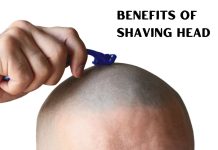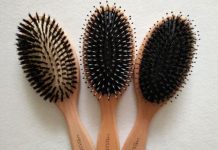Unveiling the Possible Link Between Uterine Cancer and Hair Straighteners
Uncovering a Potential Connection
The world of beauty and personal care products has always intrigued us with innovative solutions for hair styling, but could these everyday products carry hidden risks? Recent discussions have arisen regarding a potential link between hair straighteners and uterine cancer. In this article, we delve into the research, explore the chemicals found in hair straighteners, and shed light on what you need to know about this evolving topic.
Understanding Hair Straighteners: Beyond the Sleek Look
Hair straighteners have become a staple in many people’s beauty routines. These devices promise smooth and sleek hair with a single pass. From ceramic to titanium plates, hair straighteners come in various types, each boasting its unique features. However, beneath the promises of gorgeous locks lies a range of chemical compounds that warrant closer examination.
Uterine Cancer: Causes, Symptoms, and Risk Factors
Before delving into the potential link between hair straighteners and uterine cancer, let’s understand uterine cancer itself. Uterine cancer, also known as endometrial cancer, primarily affects the lining of the uterus. It’s crucial to be aware of its common symptoms, such as abnormal vaginal bleeding, pelvic pain, and changes in urinary habits. While risk factors like age and genetics play a role, emerging research suggests that environmental factors might also contribute.
The Chemicals in Hair Straighteners: A Deeper Dive
To understand the potential link between hair straighteners and uterine cancer, it’s essential to explore the chemicals commonly present in these products. Some hair straighteners contain formaldehyde-releasing compounds and other chemicals that help achieve the desired results. However, the use of such chemicals has raised concerns about their potential health impacts, especially with prolonged exposure.
Formaldehyde, a chemical known to preserve biological specimens, is often used in hair straightening treatments to lock in the sleek look. While formaldehyde itself is a concern, it’s the release of formaldehyde gas when these products are heated that poses potential risks. Exposure to high levels of formaldehyde gas has been associated with respiratory and skin irritation, making the connection between hair straighteners and uterine cancer an area of growing interest among researchers.
The Research: Is There a Connection?
Recent studies have shed light on the potential link between hair straighteners and uterine cancer. A study published in the International Journal of Cancer reported that women who used hair straighteners regularly had a higher risk of developing uterine cancer compared to those who didn’t. While these findings are noteworthy, it’s crucial to approach them with caution. Correlation does not necessarily imply causation and further research is needed to establish a direct link.
Understanding Endocrine Disruptors and Hormonal Influence
The possible connection between hair straighteners and uterine cancer also brings attention to endocrine disruptors. Endocrine disruptors are substances that can interfere with the body’s hormonal system, potentially leading to a range of health issues. Some chemicals found in hair straighteners have been identified as potential endocrine disruptors, raising concerns about their impact on hormone regulation and reproductive health.
Certain endocrine disruptors can mimic or interfere with the body’s natural hormones, leading to imbalances that may contribute to the development of various health conditions, including cancer. While research in this area is ongoing, the association between these disruptors and uterine cancer adds another layer of complexity to the discussion.
Expert Insights and Differing Opinions
Medical professionals and experts in the field offer a range of perspectives on the potential link between hair straighteners and uterine cancer. Some experts emphasize the need for more comprehensive research to establish a clear cause-and-effect relationship. Others highlight the importance of reducing exposure to potentially harmful chemicals by opting for safer haircare alternatives.
It’s crucial to consider multiple viewpoints and engage in informed discussions about this topic. While some experts believe there may be a connection, others stress that further research is required to fully understand the potential risks associated with hair straightener use.
Minimizing Exposure and Promoting Safety
As the discussion around hair straighteners and uterine cancer evolves, it’s important to prioritize safety and make informed choices. If you choose to use hair straighteners, consider the following tips to minimize exposure to potentially harmful chemicals:
- Choose Safer Products: Opt for hair straighteners that are labeled as formaldehyde-free or low in formaldehyde content. Look for products that prioritize safety and transparency in their ingredient lists.
- Proper Ventilation: Use hair straighteners in well-ventilated areas to reduce the inhalation of fumes. Good ventilation can help minimize exposure to any gases released during the styling process.
- Use at Lower Temperatures: Hair straighteners operate at various temperature settings. Using them at lower temperatures may help reduce the release of formaldehyde gas and other potentially harmful substances.
- Limit Frequency: Avoid using hair straighteners daily, as frequent exposure to heat and chemicals can increase the risk of damage to both hair and health. Consider using alternative hair styling methods on non-essential days.
Empowering Informed Choices and Raising Awareness
The potential link between hair straighteners and uterine cancer highlights the importance of informed decision-making when it comes to personal care products. Educating yourself about the ingredients in your haircare products can empower you to make choices that align with your health and well-being goals.
Reading labels, understanding ingredient lists, and exploring alternative haircare methods are all steps toward making conscious choices. By being proactive and advocating for safer products, you contribute to your health and well-being while encouraging the industry to prioritize consumer safety.
Conclusion: A Continual Pursuit of Knowledge
In the realm of beauty and personal care, staying informed is paramount. While discussions around the potential connection between hair straighteners and uterine cancer continue, it’s essential to approach the topic with a balanced perspective. While emerging research raises important questions, the complexity of these matters calls for ongoing studies and thoughtful consideration.
As consumers, our choices influence the products available in the market. By prioritizing our health and safety, we contribute to a demand for safer alternatives. The journey toward understanding the potential risks associated with hair straighteners is an ongoing one, guided by the quest for knowledge, awareness, and informed decision-making.
Q: Are hair straighteners linked to uterine cancer?
A: There is ongoing research on the potential link between hair straighteners and uterine cancer. While some studies suggest a correlation, more research is needed to establish a definitive connection.
Q: What chemicals in hair straighteners are concerning?
A: Some hair straighteners contain formaldehyde-releasing compounds that can release formaldehyde gas when heated. This gas has raised concerns due to its potential health impacts with prolonged exposure.
Q: Should I stop using hair straighteners altogether?
A: While research is inconclusive, you can take precautions. Opt for formaldehyde-free or low-formaldehyde products, use proper ventilation, and limit excessive use to reduce potential risks.
Q: Can endocrine disruptors in hair straighteners affect hormones?
A: Yes, certain chemicals in hair straighteners are potential endocrine disruptors, which could impact hormone regulation and reproductive health, although further research is needed.
Q: How can I protect myself from potential risks?
A: Choose safer hair straightener options, use them in well-ventilated areas, operate at lower temperatures, and limit frequent use to minimize potential exposure to harmful chemicals.
Q: Are there any alternatives to hair straighteners?
A: Yes, consider using heat-free styling methods, such as braiding, twisting, or air-drying, to achieve desired hairstyles without exposing your hair to high heat and chemicals.
Q: Can using hair straighteners cause immediate health issues?
A: Prolonged exposure to formaldehyde gas may lead to respiratory and skin irritation. While the link to uterine cancer requires more research, immediate reactions can occur due to exposure to certain chemicals.
Q: Is the risk of uterine cancer the same for everyone who uses hair straighteners?
A: Risk factors vary among individuals. Age, genetics, lifestyle, and other environmental factors play roles in cancer development. Some people may be more susceptible than others.
Q: Should pregnant individuals avoid using hair straighteners?
A: It’s advisable to exercise caution during pregnancy. Using hair straighteners in well-ventilated areas and minimizing exposure may be a prudent approach, given the potential risks.
Q: How can I stay updated on the latest research findings?
A: Keep an eye on reputable medical and scientific sources, such as research journals and health organizations, for updates on studies related to hair straighteners, chemicals, and health risks.




